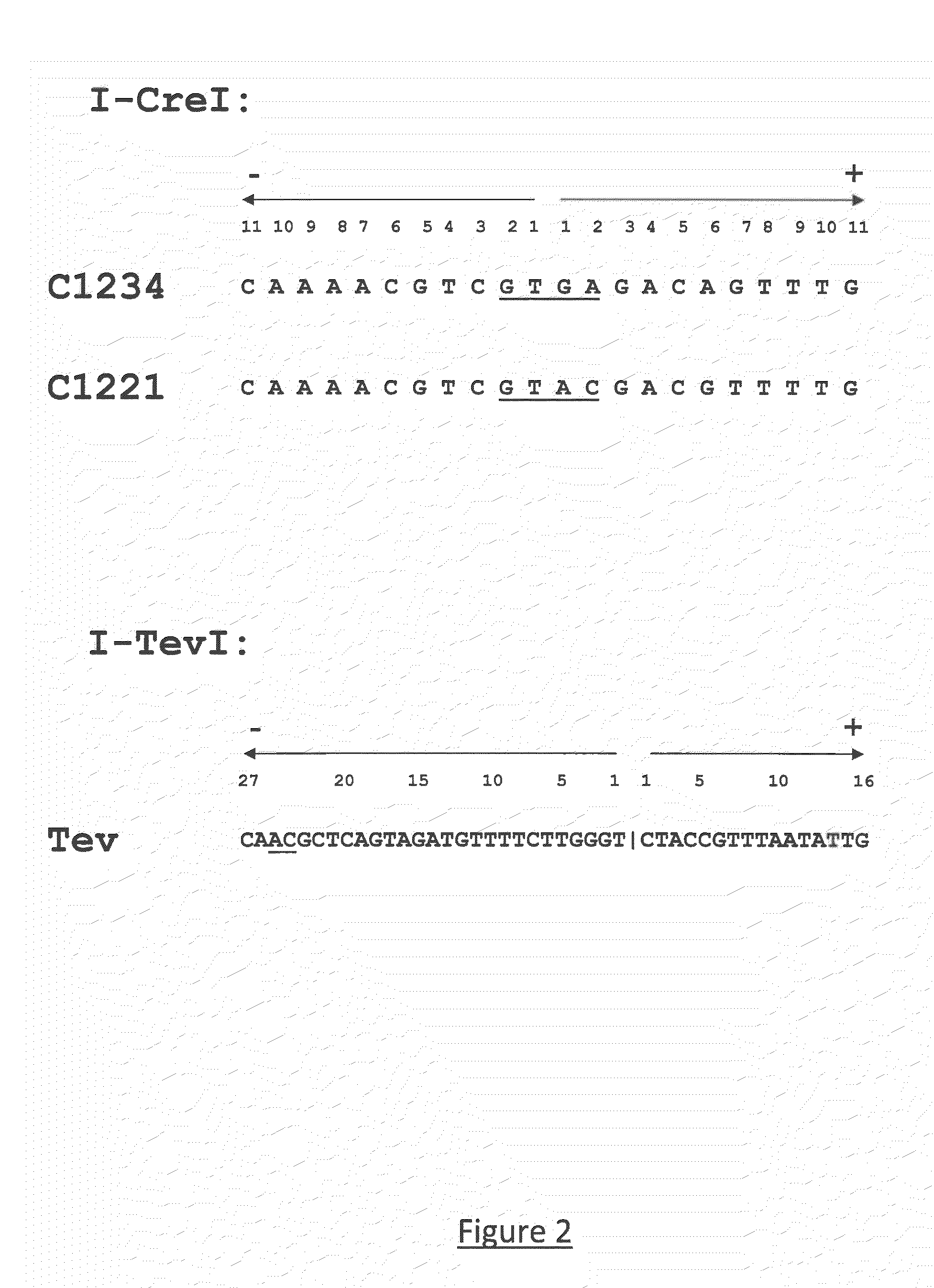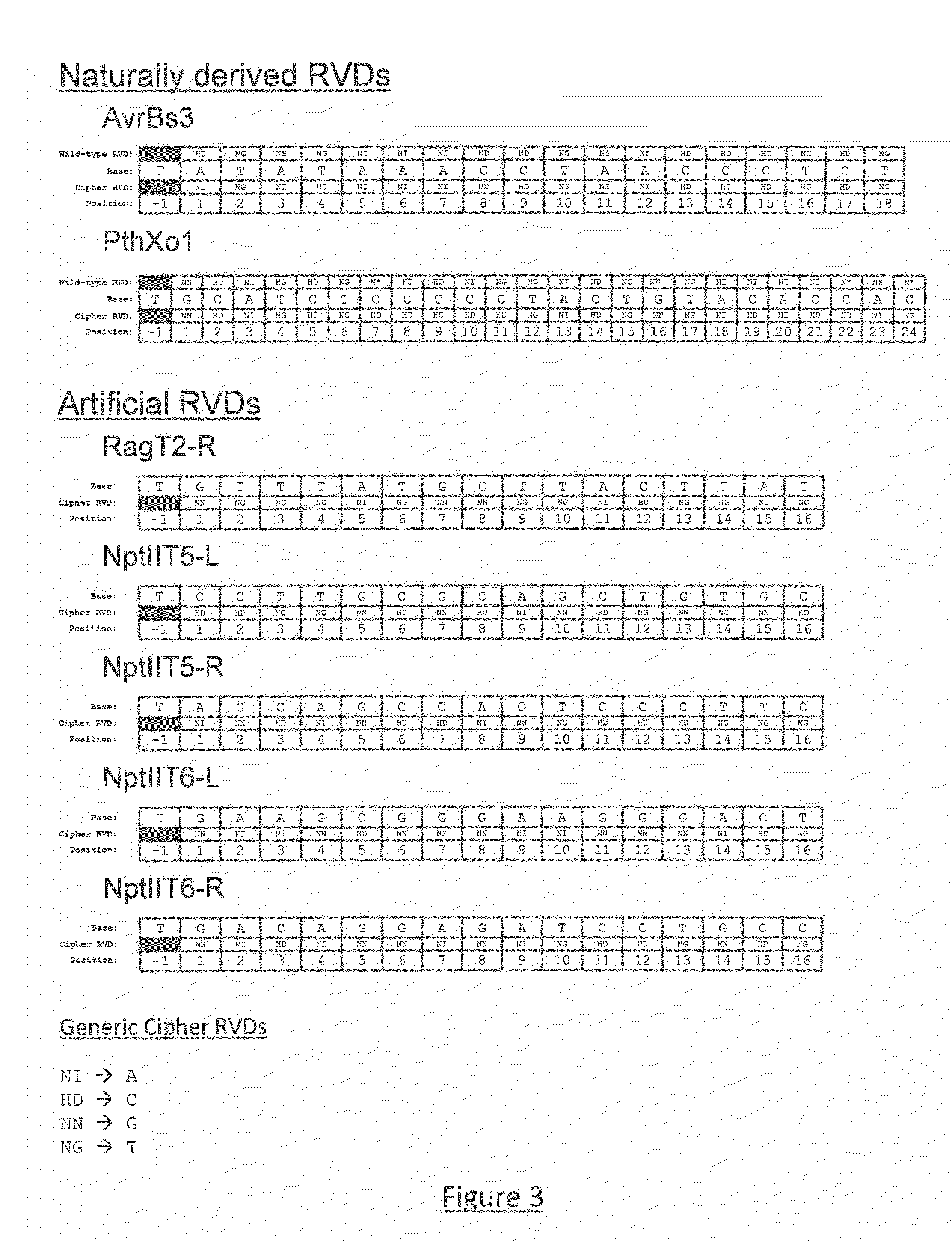Method for the generation of compact tale-nucleases and uses thereof
a technology of compact talen and nucleases, which is applied in the field of compact talen and its generation, can solve the problems of ineffectiveness, inability to use as a routine protocol in most cells, and inability to achieve the effect of enhancing the dna processing efficiency of said compact talen and simple and efficient vectorization
- Summary
- Abstract
- Description
- Claims
- Application Information
AI Technical Summary
Benefits of technology
Problems solved by technology
Method used
Image
Examples
example 1
[0295]The wild-type I-CreI meganuclease (SEQ ID NO: 106) was chosen as the parent scaffold on which to fuse the catalytic domain of I-TevI (SEQ ID NO: 107). Wild-type I-TevI functions as a monomeric cleavase of the GIY-YIG family to generate a staggered double-strand break in its target DNA. Guided by biochemical and structural data, variable length constructs were designed from the N-terminal region of 1-TevI that encompass the entire catalytic domain and deletion-intolerant region of its linker (SEQ ID NO: 109 to SEQ ID NO: 114). In all but one case, fragments were fused to the N-terminus of I-CreI with an intervening 5-residue polypeptide linker (-QGPSG-; SEQ ID NO: 103). The linker-less fusion construct naturally contained residues (-LGPDGRKA-; SEQ ID NO: 104) similar to those in the artificial linker. As I-CreI is a homodimer, all fusion constructs contain three catalytic centers (FIG. 4, where “catalytic domain”=cleavase): the natural I-CreI active site at the interface of the...
example 2
[0297]Protein-fusion scaffolds were designed based on a truncated form of I-CreI (SEQ ID NO: 106, I-CreI_X: SEQ ID NO: 121) and three different linker polypeptides (NFS1=SEQ ID NO: 98; NFS2=SEQ ID NO: 99; CFS1=SEQ ID NO: 100) fused to either the N- or C-terminus of the protein. Structure models were generated in all cases, with the goal of designing a “baseline” fusion linker that would traverse the I-CreI parent scaffold surface with little to no effect on its DNA binding or cleavage activities. For the two N-terminal fusion scaffolds, the polypeptide spanning residues 2 to 153 of I-CreI was used, with a K82A mutation to allow for linker placement. The C-terminal fusion scaffold contains residues 2 to 155 of wild-type I-CreI. For both fusion scaffold types, the “free” end of the linker (i.e. onto which a polypeptide can be linked) is designed to be proximal to the DNA, as determined from models built using the I-CreI / DNA complex structures as a starting point (PDB id: 1g9z). The tw...
example 3
[0301]Two core TALE scaffolds are generated onto which (a) different sets of RVD domains could be inserted to change DNA binding specificity, and; (b) a selection of catalytic domains could be attached, N- or C-terminal, to effect DNA cleavage (or nicking). The core scaffolds (sT1: SEQ ID NO: 134 and sT2: SEQ ID NO: 135) differ in the N- and C-terminal regions, where sT2 is a truncated variant lacking 152 amino acid residues from the N-terminus (Szurek, Rossier et al. 2002) and the last 220 residues from the C-terminus compared to sT1. In sT1, the C-terminal region is a truncation with respect to wild-type TALE domains, ending at a fortuitously defined restriction site (BamHI) in the DNA coding sequence.
[0302]Using the two core scaffolds, four “baseline” TALE DNA binding proteins (bT1-Avr=SEQ ID NO: 136, bT2-Avr=SEQ ID NO: 137, bT1-Pth ═SEQ ID NO 138 and bT2-Pth ═SEQ ID NO 139) are generated by insertion of the corresponding set of repeat domains that recognize the naturally occurri...
PUM
| Property | Measurement | Unit |
|---|---|---|
| MW | aaaaa | aaaaa |
| catalytic | aaaaa | aaaaa |
| DNA processing efficiency | aaaaa | aaaaa |
Abstract
Description
Claims
Application Information
 Login to View More
Login to View More - R&D
- Intellectual Property
- Life Sciences
- Materials
- Tech Scout
- Unparalleled Data Quality
- Higher Quality Content
- 60% Fewer Hallucinations
Browse by: Latest US Patents, China's latest patents, Technical Efficacy Thesaurus, Application Domain, Technology Topic, Popular Technical Reports.
© 2025 PatSnap. All rights reserved.Legal|Privacy policy|Modern Slavery Act Transparency Statement|Sitemap|About US| Contact US: help@patsnap.com



